Covering a continent’s worth of connectivity in three days is a tough ask – but that’s what the ITW Africa agenda will try to do. There have been several interesting developments, projects and focus areas in the African telecoms and connectivity market in 2023 – here are just five of them in areas that ITW Africa will address in September.
2Africa and Equiano coming on stream
Some of the largest investments into African connectivity in recent years have been on the subsea side. Demand from hyperscalers, cloud and content providers as well as the pure growth in user numbers has led to enormous projects coming on stream – the 15,000 km Equiano cable landed in Cape Town in 2022 and the 2Africa cable, which at 45,000km is the longest in history, is currently creeping along the Arabian peninsula after having landed in Egypt in November 2022 and South Africa in January 2023.
There are a lot of factors to consider here. The global shift in the cable ownership model will affect different markets and verticals in different ways, and the imbalance in international connections between North and South Africa remains an issue.
Plus, how will the increased capacity affect the data centre market? One pressing point to discuss is a potential land/sea mismatch – terrestrial fibre has not grown at the same pace, so there is potential either for onshore overload or offshore excess capacity.

US DFC Ghana data centre investments
Growing smartphone penetration, a vibrant enterprise sector and increasing urbanisation are driving demand in many markets across Africa, and this means data centre growth. But the whole of Africa only has 1% of global rack capacity despite hosting nearly 20% of the world’s population – so investment is required.
One area to keep an eye on is international and governmental investment in data centre provision, such as the recent announcement of the US International Development Finance Corporation to provide $300 million to Africa Data Centres to build a facility in Ghana.
This is one of several US-funded infrastructure projects going on in Africa, including a digital payments initiative in Angola and rural internet expansion in the DRC – and there is also the work of the EU-AU Digital Economy Task Force, launched in 2018 to enable investment into African connectivity.
M&A fuelling investment: the Teraco example
As well as direct funding from national organisations, investment into African telecoms is also happening on the M&A side, with heavy private equity involvement in recent years.
African data centre and colocation giant Teraco was acquired by Digital Realty in 2022, and since then is using the additional financing available to drive development across the markets it serves – not just new construction but improvements to operations in existing facilities too, particularly in power supply which is a critical problem in South Africa.
Teraco recently announced a $680m fundraising round as it looks to address this issue, with plans to build solar farms to serve existing and new facilities in an attempt to generate half its required power cleanly by 2027. In all, the planned upgrades and new construction will double the company’s data centre capacity.
100,000km of new fibre in Kenya
Fibre rollouts are a vital part of growing African connectivity, particularly in West Africa, where Togo, Liberia and Nigeria are all building out fibre broadband infrastructure.
The same goes for East Africa too, particularly Kenya, where earlier this year the government announced the start of a project to build a 100,000-km national fibre network to connect 40,000 schools, 20,000 government institutions and 13,000 health facilities. Kenya has been working on an ‘e-government’ strategy since at least 2004 , and drives to digitise public services are a key factor in the accelerated focus on connectivity developments in the country.
This latest Kenyan fibre project is structured somewhat unusually, with the government reportedly requesting private companies to build 48% of the network themselves, rather than combining with the state in a joint company. This kind of complex deal could be replicated elsewhere if successful – so this buildout is worth keeping an eye on.

Ethiopia’s telecoms market liberalisation
With impressive growth in both its population and its financial ecosystem, Ethiopia is an attractive market for connectivity development, but it has long been one of the few remaining telecommunications monopolies.
Opening up the market has been a lengthy process with some roadblocks in the way, such as a weak legal framework and the lack of a regulatory agency, and internal issues have also disrupted recent attempts to privatise assets.
But since 2020 things are back on track – a consortium led by market newcomer Safaricom is planning to invest $8bn in infrastructure development, and incumbent Ethio Telecom is actively looking for JV partners.
The Ethiopian government is also reportedly looking to revive attempts to sell a 40% stake in Ethiotel.
Source: Capacity Media















